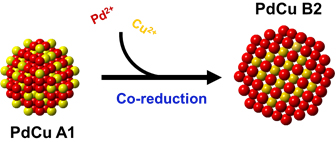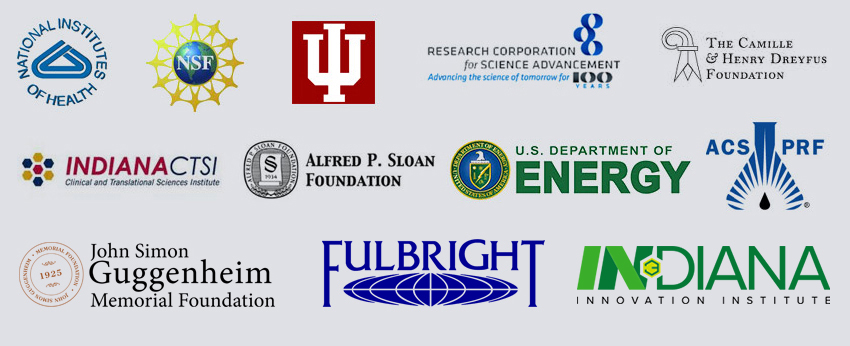Catalysis with Multimetallic Nanocrystals
 The shape of metal nanoparticles can impart geometric control in catalytic processes by selecting for symmetry matched interactions with molecular adsorbates. We are studying how the strength of these interactions can be tuned through a core@shell architecture, where the lattice mismatch between the core and shell metals result in strain.
The shape of metal nanoparticles can impart geometric control in catalytic processes by selecting for symmetry matched interactions with molecular adsorbates. We are studying how the strength of these interactions can be tuned through a core@shell architecture, where the lattice mismatch between the core and shell metals result in strain.
These structures are studied for electrocatalytic processes in fuel cells, with current efforts directed on intermetallic architectures.
Funding provided by DOE-BES Early Career Award (2013-2018) for "Decoupling the Electronic and Geometric Parameters of Metal Nanocatalysts", DOE BES Catalysis Science (2018-2021) for "Dynamics and Stain-Engineering of Multimetallic Nanocatalysts", and the Scialog Program from Research Corporation for Science Advancement (2015-2018).
For representative manuscripts, please see:

Achieving Highly Durable Random Alloy Nanocatalysts through Intermetallic Cores
ARTICLE LINK (90) Jocelyn T. L. Gamler, Alberto Leonardi, Hannah M. Ashberry, Nicholas N. Daanen, Yaroslav Losovyj, Raymond R. Unocic, Michael Engel, and Sara E. Skrabalak * "Achieving Highly Durable Random Alloy Nanocatalysts through Intermetallic Cores" ACS Nano, 2019 13, 4008. DOI: 10.1021/acsnano.8b08007.

Size-Dependent Disorder-Order Transformation in the Synthesis of Monodisperse Intermetallic PdCu Nanocatalysts
ARTICLE LINK Wang, C.; Chen, D. P.; Sang, X.; Unocic, R.; Skrabalak, S. E.* "Size-Dependent Disorder-Order Transformation in the Synthesis of Monodisperse Intermetallic PdCu Nanocatalysts" ACS Nano, 2016, 10, 6345-6353.DOI: 10.1021/acsnano.6b02669.


